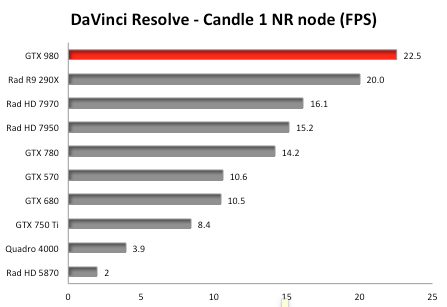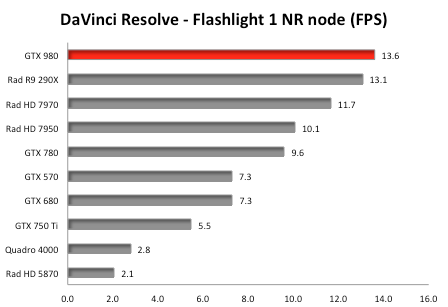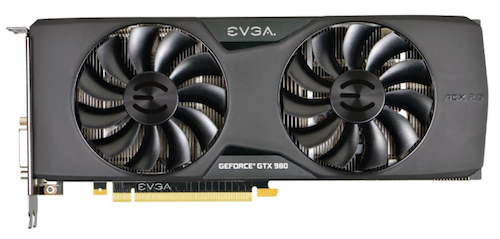GeForce GTX 980 vs 9 other GPUs running Resolve, LuxMark, and Octane Render
Posted Thursday, January 29th, 2015 by rob-ART morgan, mad scientist
We have continued to test the NVIDIA GeForce GTX 980 after our November 2014 report. This model of GPU offers high performance while using the normal 6-pin power feeds of the Mac Pro tower. That makes it a prime option for owners of Mac Pro towers -- especially when they run pro apps that lean on the GPU for help in rendering.

GRAPH LEGEND
GTX 980 = NVIDIA GeForce GTX 980 GPU (4GB, 1215MHz)
Rad R9 290X = AMD Radeon R9 290X (4GB, 1000MHz)
Rad HD 7970 = AMD Radeon HD 7970 (3GB, 925MHz)
Rad HD 7950 = AMD Radeon HD 7950 (3GB, 800MHz)
GTX 780 = NVIDIA GeForce GTX 780 (3GB, 900MHz)
GTX 680 = NVIDIA GeForce GTX 680 (2GB, 1058MHz)
GTX 570 = NVIDIA GeForce GTX 570 Ti (2.5GB, 1464MHz)
GT 750 Ti = NVIDIA GeForce GT 750 Ti (2GB, 1254MHz)
Quadro 4000 = NVIDIA Quadro 4000 (2GB, 950MHz)
Rad HD 5870 = AMD Radeon HD 5870 (1GB, 850MHz)
All GPUs were tested in a 2010 Mac Pro 3.33GHz 6-core with 24G of RAM running OS X 10.10.1 Yosemite. NVIDIA GPUs used web driver 343.02.01f01 and CUDA 6.5.37.
DaVinci Resolve 11
We found that Noise Reduction rendering during playback was pure GPU. The GPU's core utilization was at maximum. We applied one noise reduction node to the Standard Candle project and the Standard_Flashlight project. LONGEST graph bar means FASTEST in frames per second.


LuxMark 2
This is an OpenCL benchmark. We rendered the Sala scene (488K triangles) using GPUs only. LONGEST graph bar means FASTEST in thousands of samples per second.

Octane Render 2
This is a "GPU only" standalone renderer that can process scenes created in Maya, ArchiCAD, Cinema 4D, etc. -- and does so in a fraction of the time it takes with a CPU based renderer. However, it only runs only on CUDA capable NVIDIA graphics cards. We used the DEMO version with a test scene called octane_benchmark.ocs. For our test we selected RenderTarget PT (Path Tracing). SHORTEST graph bar means FASTEST render time in seconds.


INSIGHTS
The NVIDIA GeForce GTX 980 beats all other GPUs rendering noise reduction in DaVinci Resolve.
As for OpenCL in LuxMark, one GPU edged out the GTX 980: the AMD Radeon R9 290X. The GTX 980 still impresses since it is twice as fast running LuxMark than the next fastest NVIDIA GPU, the GTX 780.
Only NVIDIA GPUs appeared in the Octane Render graph. That's because only CUDA capable GPUs are compatible of rendering in that app. The GTX 980 edges out the GTX 780 and blows away all the other NVIDIA GPUs. Notice we included results for dual 980s. That's a teaser for an upcoming article.
We wanted to include a graph showing After Effects CC 2014 rendering the Robot ray-trace 3D project, but AE gives us ray-trace loading errors when we attempt it with the GTX 980. Once that issue is resolved, we will add that graph to this page.
The GeForce GTX 980 may not have dominated every test but keep in mind that it ran with only the Mac Pro tower's internal power no matter how hard it was stressed. That can't be said of the GeForce GTX 780, Radeon R9 290X, and Radeon HD 7970 -- all of which had one power port plugged into an auxillary power supply to prevent possible self-power-down by the Mac Pro (especially when running FurMark).
Comments? Suggestions? Feel free to email me,
Follow me on Twitter @barefeats

WHERE TO BUY APPLE products:
USA readers can help us earn a commission by using this Apple Store USA link or by clicking on any Apple display ad. Live outside the USA? No problem. We are affiliated with these Apple Stores: